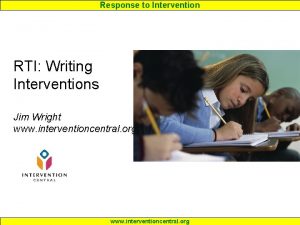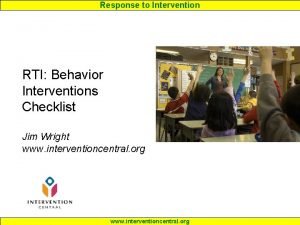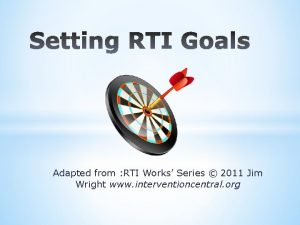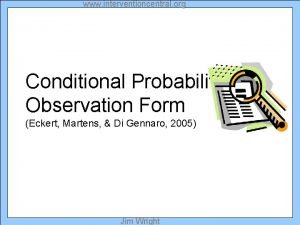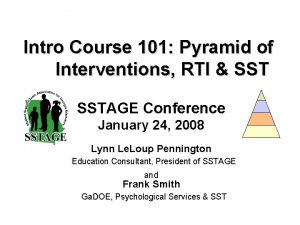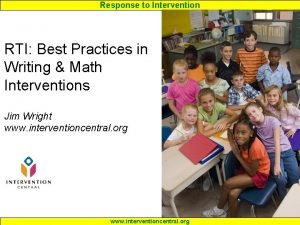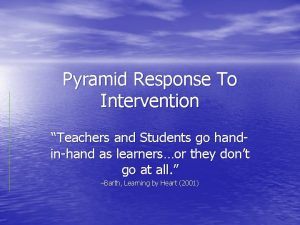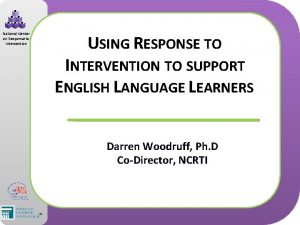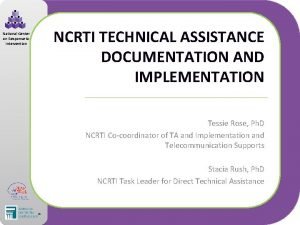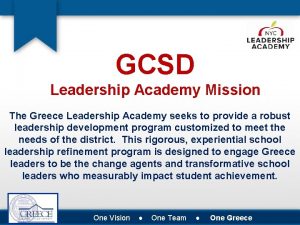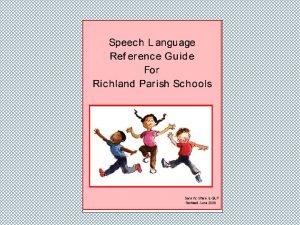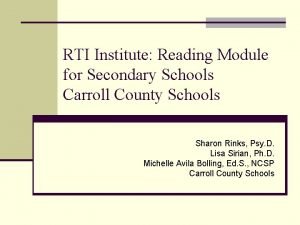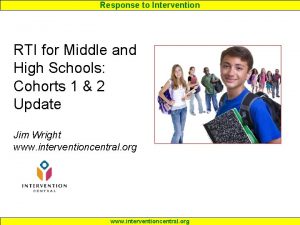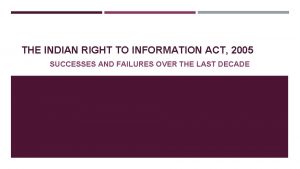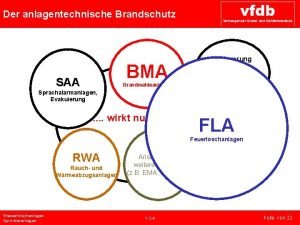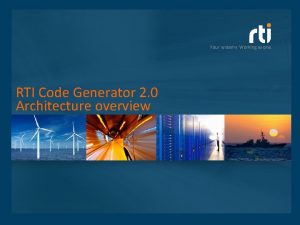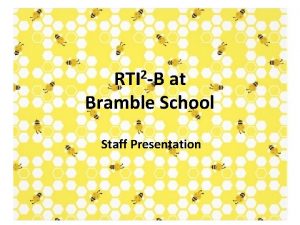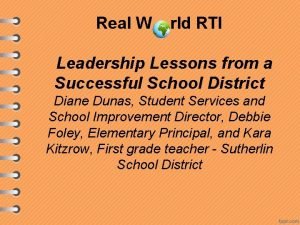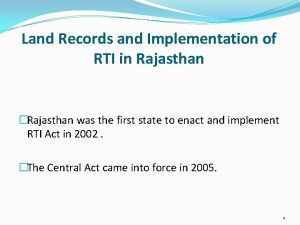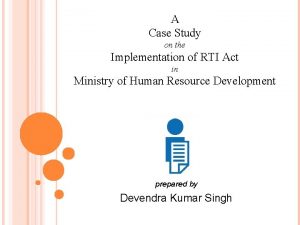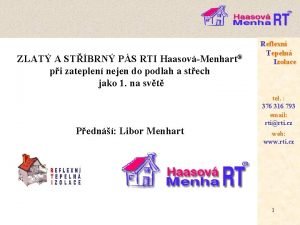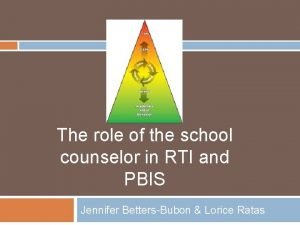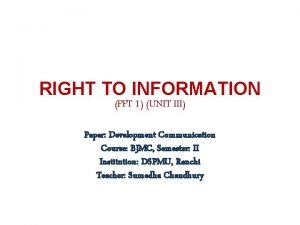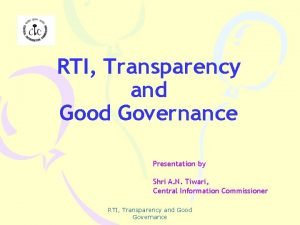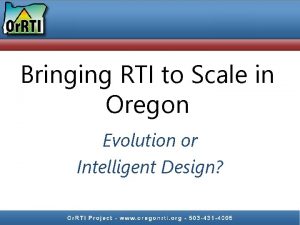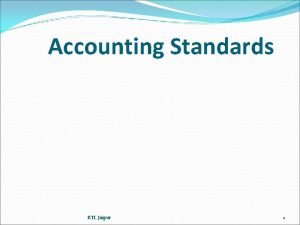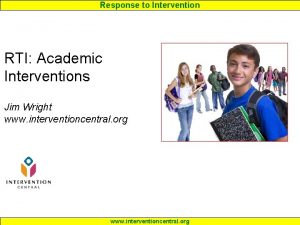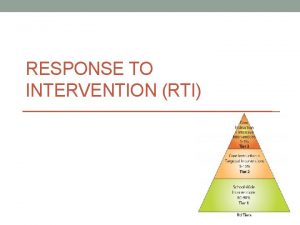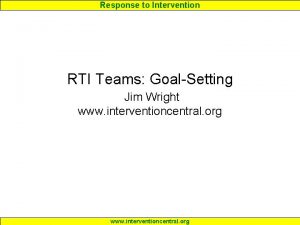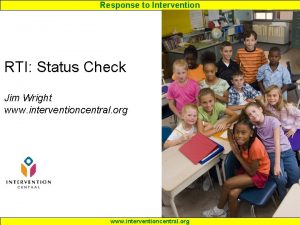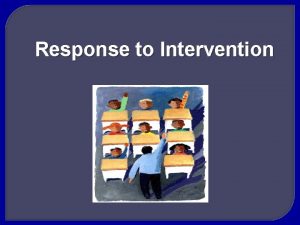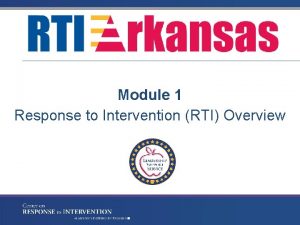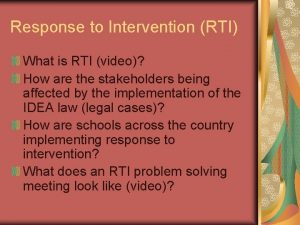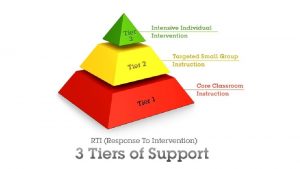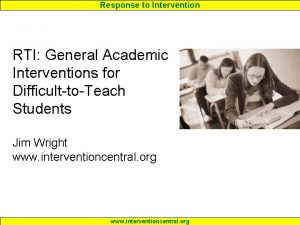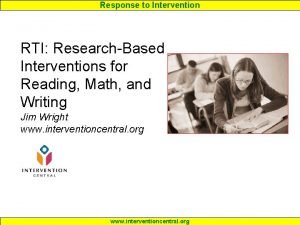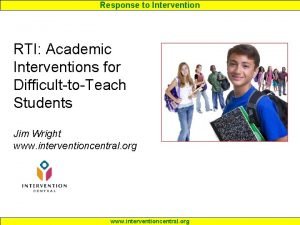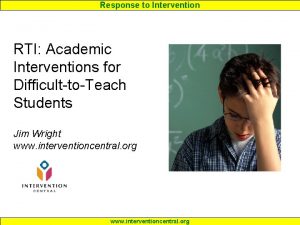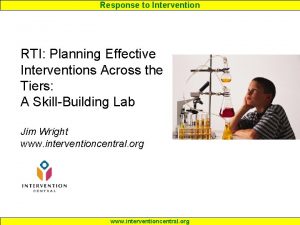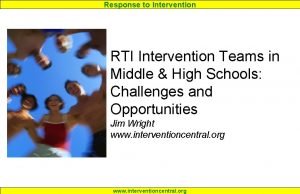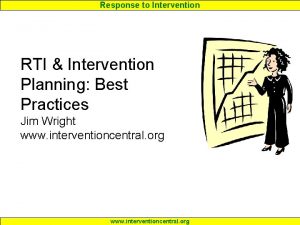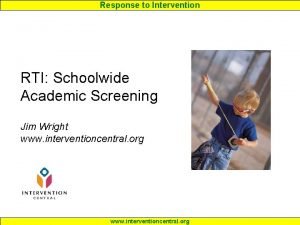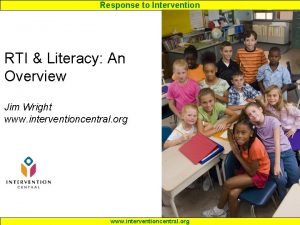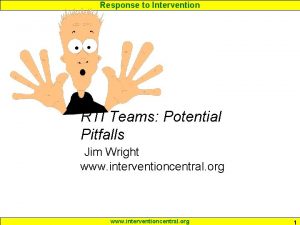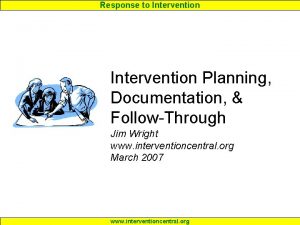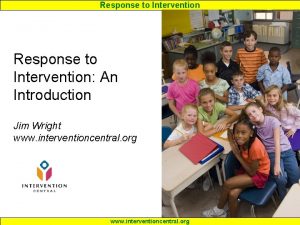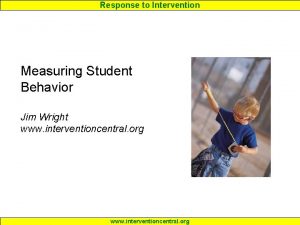Response to Intervention RTI Writing Interventions Jim Wright
































- Slides: 32

Response to Intervention RTI: Writing Interventions Jim Wright www. interventioncentral. org

Response to Intervention Elbow Group Activity: When was your ‘writing breakthrough’ point? • In your group, discuss when each member felt that they reached the ‘breakthrough’ point when they felt they were competent writers. • Be prepared to share your discussion with the larger group. www. interventioncentral. org 2

Response to Intervention "If all the grammarians in the world were placed end to end, it would be a good thing. " – Oscar Wilde www. interventioncentral. org 3

Response to Intervention Graham, S. , & Perin, D. (2007). Writing next: Effective strategies to improve writing of adolescents in middle and high schools – A report to Carnegie Corporation of New York. Washington, DC Alliance for Excellent Education. Retrieved from http: //www. all 4 ed. org/files/ Writing. Next. pdf www. interventioncentral. org 4

Response to Intervention The Effect of Grammar Instruction as an Independent Activity “Grammar instruction in the studies reviewed [for the Writing Next report] involved the explicit and systematic teaching of the parts of speech and structure of sentences. The meta-analysis found an effect for this type of instruction for students across the full range of ability, but …surprisingly, this effect was negative…Such findings raise serious questions about some educators’ enthusiasm for traditional grammar instruction as a focus of writing instruction for adolescents…. Overall, the findings on grammar instruction suggest that, although teaching grammar is important, alternative procedures, such as sentence combining, are more effective than Source: Graham, S. , & Perin, D. (2007). Writing next: Effective strategies to improve writing of traditional approaches improving the quality of adolescents in middle and high schools –for A report to Carnegie Corporation of New York. Washington, DC Alliance for Excellent Education. www. interventioncentral. org 5

Response to Intervention Domains of writing to be assessed (Robinson & Howell, 2008): • • • Fluency/Text Generation: Facility in getting text onto paper or typed into the computer. (NOTE: This element can be significantly influenced by student motivation. ) Syntactic Maturity: This skill includes the: – Ability to discern when a word string meets criteria as a complete sentence – Ability to write compositions with a diverse range of sentence structures Semantic Maturity: Writer’s use of vocabulary of range and sophistication Source: Robinson, L. K. , & Howell, K. W. (2008). Best practices in curriculum-based evaluation & written expression. In A. Thomas & J. Grimes (Eds. ), Best practices in school psychology V (pp. 439 -452). Bethesda, MD: National Association of School Psychologists. www. interventioncentral. org 6

to Intervention Students must. Response learn that writing is a process (plan, write, revise) not a static product. www. interventioncentral. org The Horse in Motion 7

Response to Intervention Domains of writing to be assessed (Robinson & Howell, 2008): 5 -Step Writing Process: (Items in bold are iterative): 1. Planning. The student carries out necessary prewriting planning activities, including content, format, and outline. 2. Drafting. The student writes or types the composition. 3. Revision. The student reviews the content of the composition-in-progress and makes changes as needed. After producing an initial written draft, the student considers revisions to content before turning in for a grade or evaluation. 4. Editing. The student looks over the composition Source: Robinson, L. K. , & Howell, K. W. (2008). Best practices in curriculum-based evaluation & written corrects any Best mechanical expression. In and A. Thomas & J. Grimes (Eds. ), practices in schoolmistakes psychology V (pp. 439 -452). Bethesda, MD: National Association of School Psychologists. (capitalization, www. interventioncentral. org punctuation, etc. ). 8

Response to Intervention Elements of effective writing instruction for adolescents: 1. Writing Process (Effect Size = 0. 82): Students are taught a process for planning, revising, and editing. 2. Summarizing (Effect Size = 0. 82): Students are taught methods to identify key points, main ideas from readings to write summaries of source texts. 3. Cooperative Learning Activities (‘Collaborative Writing’) (Effect Size = 0. 75): Students are placed in pairs or groups with learning activities that focus on collaborative use of the writing process. 4. Goal-Setting (Effect Size = 0. 70): Students set specific ‘product goals’ for their writing and then check their attainment of those self-generated goals. Source: Graham, S. , & Perin, D. (2007). Writing next: Effective strategies to improve writing of adolescents in middle and high schools – A report to Carnegie Corporation of New York. Washington, DC Alliance for Excellent Education. Retrieved from http: //www. all 4 ed. org/files/Writing. Next. pdf www. interventioncentral. org 9

Response to Intervention Elements of effective writing instruction for adolescents: 5. Writing Processors (Effect Size = 0. 55): Students have access to computers/word processors in the writing process. 6. Sentence Combining (Effect Size = 0. 50): Students take part in instructional activities that require the combination or embedding of simpler sentences (e. g. , Noun-Verb. Object) to generate more advanced, complex sentences. 7. Prewriting (Effect Size = 0. 32): Students learn to select, develop, or organize ideas to incorporate into their writing by participating in structured ‘pre-writing’ activities. 8. Inquiry Activities (Effect Size = 0. 32): Students become Source: Graham, S. , & Perin, D. (2007). Writing next: Effective strategies to improve writing of actively engaged analyzing adolescents in middle and high schoolsresearchers, – A report to Carnegiecollecting Corporation of New York. Washington, DC Alliance for Excellent Education. Retrieved from http: //www. all 4 ed. org/files/Writing. Next. pdf information to guide the ideas and content for writing www. interventioncentral. org 10

Response to Intervention Elements of effective writing instruction for adolescents: 9. Process Writing (Effect Size = 0. 32): Writing instruction is taught in a ‘workshop’ format that “ stresses extended writing opportunities, writing for authentic audiences, personalized instruction, and cycles of writing” (Graham & Perin, 2007; p. 4). 10. Use of Writing Models (Effect Size = 0. 25): Students read and discuss models of good writing and use them as exemplars for their own writing. 11. Writing to Learn Content (Effect Size = 0. 23): The instructor incorporates writing activities as a means to have students learn content material. Source: Graham, S. , & Perin, D. (2007). Writing next: Effective strategies to improve writing of adolescents in middle and high schools – A report to Carnegie Corporation of New York. Washington, DC Alliance for Excellent Education. Retrieved from http: //www. all 4 ed. org/files/Writing. Next. pdf www. interventioncentral. org 11

Response to Intervention Writing Skills Checklist www. interventioncentral. org

Response to Intervention Writing ‘Blockers www. interventioncentral. org 13

Response to Intervention Physical Production of Writing Problem? Writing Competency Sample Intervention Ideas ___Y ___N Writing Speed. Writes words on the page at a rate equal or nearly equal to that of classmates Teach keyboarding skills Allow student to dictate ideas into a tape-recorder and have a volunteer (e. g. , classmate, parent, school personnel) transcribe them ___Y ___N Handwriting is legible to most readers Provide training in handwriting Teach keyboarding skills www. interventioncentral. org 14

Response to Intervention Origins of the Latin Alphabet: Early Greek Alphabet Boustrophedon: ‘ox trail’: Script alternates between leftto-right and right-to-left Source: http: //www. translexis. demon. co. uk/new_page_2. htm www. interventioncentral. org 15

Response to Intervention Mechanics & Conventions of Writing Problem? Writing Competency Sample Intervention Ideas ___Y ___N Grammar & Syntax. Knowledge of grammar (rules governing use of language) and syntax (grammatical arrangement of words in sentences) is appropriate for age and/or grade placement Teach rules of grammar, syntax Have students compile individualized checklists of their own common grammar/syntax mistakes; direct students to use the checklist to review work for errors before turning in ___Y ___N Spelling skills are appropriate for age and/or grade placement Have student collect list of own common misspellings; assign words from list to study; quiz student on list items Have student type assignments and use spell-check www. interventioncentral. org 16

Response to Intervention "The difference between the right word and the almost right word is the difference between lightning and the lightning bug. " – Mark Twain www. interventioncentral. org 17

Response to Intervention "Your manuscript is both good and original. But the part that is good is not original, and the part that is original is not good. " – Samuel Johnson www. interventioncentral. org 18

Response to Intervention Writing Content Problem Writing Competency ? Sample Intervention Ideas ___Y ___N Vocabulary in written work is age/grade appropriate Compile list of key vocabulary and related definitions for subject area; assign words from list to study; quiz student on definitions of list items Introduce new vocabulary items regularly to class; set up cooperative learning activities for students to review vocabulary ___Y ___N Word Choice. Distinguishes wordchoices that are appropriate for informal (colloquial, slang) written discourse vs. formal discourse Present examples to the class of formal vs. informal word choices Have students check work for appropriate word choice as part of writing revision process ___Y ___N Audience. Identifies targeted audience for writing assignments and alters written content to match needs of projected audience Direct students to write a ‘targeted audience profile’ as a formal (early) step in the writing process; have students evaluate the final writing product to needs of targeted audience during the revision process ___Y ___N Plagiarism. Identifies when to credit authors for use of excerpts quoted verbatim or unique ideas taken from other written works Define plagiarism for students. Use plentiful examples to show students acceptable vs. unacceptable incorporation of others’ words or ideas into written compositions www. interventioncentral. org 19

Response to Intervention "Nothing is particularly hard if you divide it into small jobs. " – Henry Ford www. interventioncentral. org 20

Response to Intervention Writing Preparation Problem Writing Competency ? Sample Intervention Ideas ___Y ___N Topic Selection. Independently selects appropriate topics for writing assignments Have student generate list of general topics that interest him or her; sit with the student to brainstorm ideas for writing topics that relate to the student’s own areas of interest ___Y ___N Writing Plan. Creates writing plan by breaking larger writing assignments into sub-tasks (e. g. , select topic, collect source documents, take notes from source documents, write outline, etc. ) Create generic pre-formatted work plans for writing assignments that break specific types of larger assignments (e. g. , research paper) into constituent parts. Have students use these plan outlines as a starting point to making up their own detailed writing plans. ___Y ___N Note-Taking. Researches topics by writing notes that capture key ideas from source material Teach note-taking skills; have students review note-cards with the teacher as quality check. www. interventioncentral. org 21

Response to Intervention "When I sit at my table to write, I never know what it’s going to be until I'm under way. I trust in inspiration, which sometimes comes and sometimes doesn't. But I don't sit back waiting for it. I work every day. " – Alberto Moravia www. interventioncentral. org 22

Response to Intervention Writing Production & Revision Problem? Writing Competency ___Y ___N Adequate ‘Seat Time’. Allocates realistic amount of time to the act of writing to ensure a quality final product Sample Intervention Ideas ___Y ___N Oral vs. Written Work. Student’s dictated and written passages are equivalent in complexity and quality Use teacher’s experience and information from proficient student writers to develop estimates of minimum writing ‘seat time’ needed to produce quality products for ‘typical’ writing assignments (e. g. , 5 -paragraph opinion essay; 10 -page term paper). Share with students. Have students keep a writing diary to record amount of time spent in act of writing for each assignment. Require that this information be submitted along with the students’ assignment. (Additional idea: Consider asking parents to monitor and record their child’s writing time. ) Allow student to dictate ideas into a tape-recorder and have a volunteer (e. g. , classmate, parent, school personnel) transcribe them Permit the student to use speech-to-text software (e. g. , Dragon Naturally Speaking) to dictate first drafts of writing assignments. www. interventioncentral. org 23

Response to Intervention Writing Production & Revision (Cont. ) Problem? Writing Competency Sample Intervention Ideas ___Y ___N Revision Process. Revises initial written draft before turning in for a grade or evaluation Create a rubric containing the elements of writing that students should review during the revision process; teach this rubric to the class; link a portion of the grade on writing assignments to students’ use of the revision rubric. ___Y ___N Timely Submission. Turns in written assignments (class work, homework) on time Provide student incentives for turning work in on time. Work with parents to develop home-based plans for work completion and submission. Institute school-home communication to let parents know immediately when important assignments are late or missing. www. interventioncentral. org 24

Response to Intervention Writing ‘Blockers’ www. interventioncentral. org 25

Response to Intervention Sentence Combining Students with poor writing skills often write sentences that lack ‘syntactic maturity’. Their sentences often follow a simple, stereotyped format. A promising approach to teach students use of diverse sentence structures is through sentence combining. In sentence combining, students are presented with kernel sentences and given explicit instruction in how to weld these kernel sentences into more diverse sentence types either – by using connecting words to combine multiple sentences into one or – by isolating key information from an otherwise Sources: Saddler, B. (2005). Sentence combining: A sentence-level writing intervention. The Reading superfluous sentence and embedding that important Teacher, 58, 468 -471. information into theto sentence base sentence. Strong, W. (1986). Creative approaches combining. Urbana, OL: ERIC Clearinghouse on Reading and Communication Skill & National Council of Teachers of English. www. interventioncentral. org 26

Response to Intervention Formatting Sentence Combining Examples www. interventioncentral. org 27

Response to Intervention www. interventioncentral. org 28

Response to Intervention www. interventioncentral. org 29

Response to Intervention www. interventioncentral. org 30

Response to Intervention Team Activity: Use of Sentence Combining as a Writing Strategy Across Content Areas… : • Discuss the sentence-combining strategy discussed in this workshop. • Brainstorm ways that schools can promote the use of this strategy across content areas to encourage students to write with greater ‘syntactic maturity’. www. interventioncentral. org 31

Response to Intervention END www. interventioncentral. org 32
 Writing interventions
Writing interventions Jim wright rti
Jim wright rti Jim wright rti
Jim wright rti Jim wright intervention central
Jim wright intervention central Rti interventions examples
Rti interventions examples Rti interventions list
Rti interventions list Jim wright oma
Jim wright oma Pyramid response to intervention
Pyramid response to intervention National center for response to intervention
National center for response to intervention Ncrti
Ncrti Simplifying response to intervention
Simplifying response to intervention Serp.doe.louisiana
Serp.doe.louisiana Rti graph
Rti graph Rti scheduler
Rti scheduler Rti act 2005 introduction
Rti act 2005 introduction Hmrc rti gtax
Hmrc rti gtax Trockenalarmventilstation
Trockenalarmventilstation Rti templates
Rti templates Rti 2
Rti 2 Rti meaning real estate
Rti meaning real estate Heraus ragen
Heraus ragen Rti portal rajasthan
Rti portal rajasthan Rti zeromq
Rti zeromq Pegasus payroll rti
Pegasus payroll rti Suo-moto meaning
Suo-moto meaning Rti izolace
Rti izolace Rti examples
Rti examples Rti act ppt
Rti act ppt Transparency of good governance
Transparency of good governance Upper rti
Upper rti Rti oregon
Rti oregon List of accounting standards in india
List of accounting standards in india Natural response and forced response
Natural response and forced response
